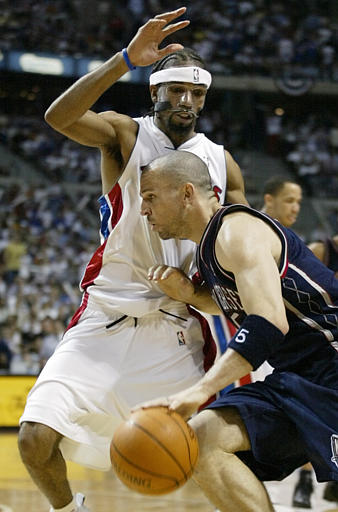
Kevin Garnett and Paul Pierce have been teammates for seven years now, six in Boston with the Boston Celtics, and this year with the Brooklyn Nets. After a rough start to the 2013-14 season, there were whispers (okay, loud screams) that they’d finally lost that step they’d been eternally clinging to.
After another solid victory over an Eastern Conference playoff team (which, however lifeless a moniker, still rings true), the Nets have surged to a 14-5 record in the calendar year of 2014. They’ve done it with some wild changes in their lineup, with All-Star guards Deron Williams and Joe Johnson struggling, and with newcomer Shaun Livingston in their starting lineup.
But through the calendar year, it’s Garnett and Pierce who have made the difference.
In 2014, the Nets have outscored opponents by a devastating 16.6 points per 48 minutes with Pierce and Garnett sharing the floor, the most of any two-man duo with more than 140 minutes together (or 10 minutes per game in 2014).
Pierce has played all 19 games in the calendar year, averaging an efficient 14.6 points, 4.3 rebounds, and 2.7 assists per game. He’s shooting 46.8 percent from the field and 38.2 percent from three-point range, capped by a 25-point, 9-11 shooting performance in the team’s 105-89 laugher over the Charlotte Bobcats. Pierce played so well that the team’s starters (minus Livingston) sat the entire fourth quarter.
Pierce doesn’t create open space with incredible quickness or verticality, but chalks it up to his basketball mind, which he says is “one of the great basketball minds in the game.”
“I don’t have the same step I had, 10, 12 years ago,” he admitted. “A lot of times I’m just trying to take advantage of different cuts, playing off screens, just kind of use my basketball IQ out there. There’s a lot of guys who are faster, jump higher, but I feel I have one of the great basketball minds in the game to where I’ll figure it out.”
Both Garnett and Pierce have made their impacts playing out of their natural position. Due to Brook Lopez’s season-ending foot injury, Garnett has slid to the 5 — a position he, to put it nicely, doesn’t like playing, and Pierce has moved to the power forward position.
“I think since (Pierce’s) moved to the 4, it’s allowed him to exploit some mismatches,” Williams added.
Garnett’s impact is more subtle, but still distinct. His biggest impact on the stat sheet has been in his jump shooting: Garnett’s shot a red-hot 57.6 percent in 2014, averaging 7.7 points per game. He also leads the NBA in defensive rebounding percentage.
But it’s Garnett’s off-the-scorebook contributions that have made him so deadly in the new calendar year: the 37-year-old forward is the team’s undercover point guard, running the offense out of the high post as a fulcrum. If there’s no open man, they’ll get the ball to Garnett, whose near-unparalleled court vision for a center gives him the ability to find open men all over the floor.
Defensively, Garnett’s impact near the rim is undeniable: the team’s defending the paint like the league-best Indiana Pacers with Garnett on the floor.
“They’re the glue of this team,” Kidd said. “When you look at their careers, they’ve been through a lot and seen a lot — slow starts, fast starts. There’s never any panic and you can see that in their play. Sometimes veteran guys take a little bit longer to get to the starting line, but the guys are playing at a high level and you can see that with Paul and Kevin.”

















